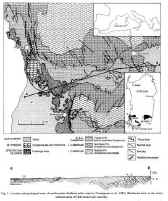|
Sedimentary Geology, 72 (1991), 97-115
ORDOVICIAN ALLUVIAL FAN TO MARINE SHELF TRANSITION IN SW SARDINIA, WESTERN
MEDITERRANEAN SEA: TECTONICALLY ("SARDIC PHASE") INFLUENCED CLASTIC
SEDIMENTATION
I.P.MARTINI1, M.TONGIORGI2, G. OGGIANO3 and
T. COCOZZA4
1Department of Land Resource Science, University of Guelph, Guelph, Ont.
N1G 2Wl, Canada
2Dipartimento delle Scienze della Terra, Universita' di Pisa, Pisa,
Italy
3Instituto Policattedra di Scienze Geologico-Mineralogiche,
Universita' di Sassari, Sassari, Italy
4Dipartimento di Geologia, Universita' di Siena, Siena, Italy
¡¡
 A localized Lower Ordovician, early Caledonian structural event ("Sardic
phase") is recorded in SW Sardinia by an angular and erosional
unconforrnity, fauJting, and mild folding. This event was accompanied by
sedimentation of a transgressive, clastic unit ("Puddinga Beds") that
is particularly well developed along a major fault system (Gonnesa fault zone).
There, the "Puddinga Beds" range from basal interfingering fans (some
formed by coarse carbonate and schist-clasts others by schist-clasts only), to
fluvio-lacustrine mud and gravelly sandstone, to coastal muddy and sandy
deposits, and to fossiliferous restricted marine shelf sediments. A localized Lower Ordovician, early Caledonian structural event ("Sardic
phase") is recorded in SW Sardinia by an angular and erosional
unconforrnity, fauJting, and mild folding. This event was accompanied by
sedimentation of a transgressive, clastic unit ("Puddinga Beds") that
is particularly well developed along a major fault system (Gonnesa fault zone).
There, the "Puddinga Beds" range from basal interfingering fans (some
formed by coarse carbonate and schist-clasts others by schist-clasts only), to
fluvio-lacustrine mud and gravelly sandstone, to coastal muddy and sandy
deposits, and to fossiliferous restricted marine shelf sediments.
The existence of the
slightly compressive "Sardic phase" in SW Sardinia and a quasi-coeval
calc-alkaline volcanism and an extensional structural phase ("Sarrabese
phase") in central-east Sardinia, suggest transcurrent faulting. The
calc-alkaline acid volcanism is also interpreted by some authors to indicate
that the rifted basins developed in backarc position. The non-volcanic sequence
of SW Sardinia analyzed in this paper was probably formed in basins developed on
the northern margin of the Gondwanaland craton. This Sardinian system may be the
eastward extension ot transcurrent rifts which have also been recently reported
from NW Spain.
Structural activity has been the predominant control on
sedimentation; however, worldwide, recurring, low sea-level stands may have
influenced the sedimentation of the lower part of the "Puddinga Beds",
and the deglaciation of the Saharan Ice Sheet has contributed to the uppermost
Ordovician-early Silurian deepening of the euxinic shelf.
|